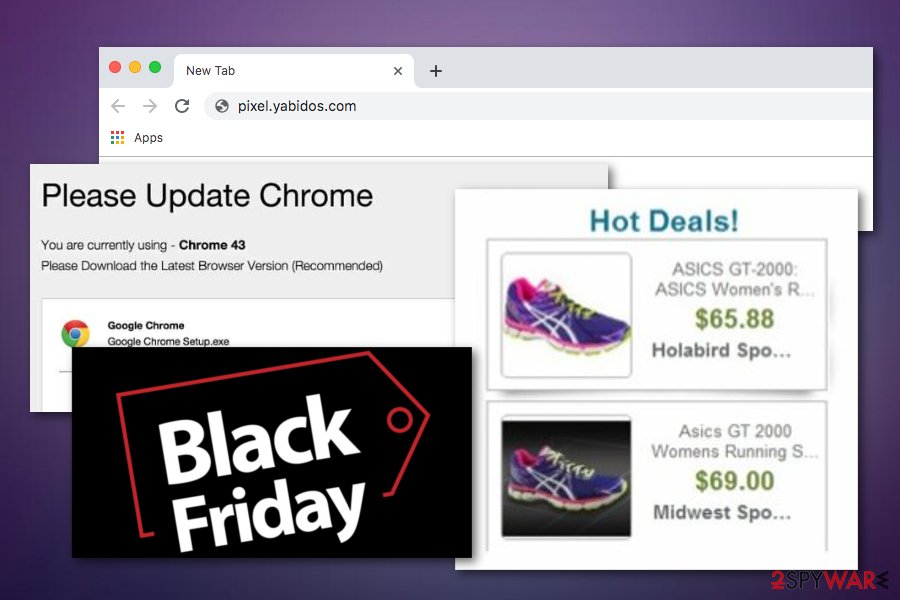Pixel.yabidos.com virus (Virus Removal Instructions) - updated Sep 2019
Pixel.yabidos.com virus Removal Guide
What is Pixel.yabidos.com virus?
Pixel.yabidos.com – an adware-related domain that has a mission of redirecting you to an affiliate place

Pixel.yabidos.com is an adware-based program that seeks to gain income from redirects[1] to sponsored networks and frequent advertising. The installation of this threat happens unexpectedly and you might not notice the program at first. However, later on, Pixel.yabidos.com malware will supposedly show itself by changing your browser's default homepage and inserting bogus extensions/plug-ins. Additionally, you might find the program running in your Task Manager.[2]
The name of Pixel.yabidos.com virus signals about unwanted activities and potential danger. First of all, this program starts pushing annoying adverts, notifications, and deals during browsing sessions. You might end up with false update claims, misleading program offers, and various suspicious surveys.
| Name | Pixel.yabidos.com |
|---|---|
| Type | Adware app |
| Category | Potentially unwanted application |
| Activities | Pushing advertising content, redirecting to sponsored websites, gathering non-personal information |
| Distribution | Free software packages and unsecured websites/services are the most common places where adware might be found |
| Prevention | Opt for the Custom/Advanced configuration to avoid unwanted downloads, always have an active antimalware tool |
| Elimination | Use software such as FortectIntego for investigating the system. Afterward, try the manual or automatical removal methods which are both explained at the end of this web page |
Do not click on any content that is provided by Pixel.yabidos.com as it might be potentially malicious. By saying this we mean that the adware might provoke you to buy false software and spend money on useless services. Also, if you tend to enter various surveys, providing personal information about yourself might relate to future data theft.
However, mostly, Pixel.yabidos.com developers do not care about the content that is provided through ads as their only goal is to generate income. Sometimes, these people collect information about the latest deals search and other information regarding the user's browsing activities, sessions, and habits.
Later on, the developers find this type of information very helpful as it can be used for creating attractive-looking advertisements and collecting a bigger number of users. In addition, Pixel.yabidos.com might cause redirects to unknown domains during which you might be put on a malicious website.

Landing on bogus locations and clicking on content that is provided there might relate to secret installation of malware. Redirecting almost always happens with adware[3] such as Pixel.yabidos.com and you need to be aware of it. Usually, redirects are the way to promote other developer-sponsored sources and programs.
If you want to stop the intrusive ad flow and end all of the redirecting activities during your browsing tasks, you need to remove Pixel.yabidos.com from your operating system and web browser applications, including Google Chrome, Mozilla Firefox, Internet Explorer, Microsoft Edge, and Safari.
Pixel.yabidos.com removal can be done in two different ways. However, the automatical method is more recommended as it is safer and easier to go on with. Besides, we suggest all users downloading/installing a program such as FortectIntego or SpyHunter 5Combo Cleaner for scanning the entire machine for potentially bogus content and adware-based software.

The occurrence and prevention of adware programs
According to Virusai.lt security reports,[4] the developers of various adware-based programs are aware that almost none of the users read the installation instructions after downloading a new program. Thus, they cover the potentially unwanted program under “Basic” settings. Once the “Install” button is hit, the PUP gets into the system unnoticed.
If you do not want your PC to get infected again, take note of these tips. First of all, you should select the “Custom” installation mode. In addition, it might also be named as the “Advanced” variant. Once you accomplish this task, continue by deselecting all bogus products from the downloading list.
Continuously, adware-related products can be delivered through unsecured networks and their services. If you ever get a visit to a third-party website, prevent yourself from clicking on advertisements and hyperlinks that might be added there as you might accidentally launch the adware/PUP downloading process.
Last but not least, always remember that you need automatical safety while carrying out browsing and computing tasks. For this purpose, choose a reputable antivirus program to download and keep it updated regularly.
Pixel.yabidos.com removal steps for your OS and browser app
There are two main methods to eliminate the adware program. The first option involves manual elimination. If you want to get assured that the hijacker is completely removed, you need to follow each step carefully. In case you struggle with thorough work, install an anti-spyware program to remove pixel.yabidos.com for you. This method might be more convenient since the tool detects various potentially suspicious files and removes them.
Additionally, the security program ensures real-time protection against high-scale viruses such as trojans, worms or even ransomware. You may also help the program monitor your computer safety by carefully installing new programs and avoiding to install browser hijackers rather than legitimate search engines. All in all, cautiousness might save you from the counterattack of pixel.yabidos.com virus.
Also, if you think that you have good skills in the virus elimination field, you can complete the manual version of Pixel.yabidos.com removal process. Below you will find some detailed instructing steps that will allow you to clean both Windows and Mac operating systems. In addition, we have also provided cleaning guidelines for browsers such as Chrome, Firefox, Edge, Explorer, and Safari.
You may remove virus damage with a help of FortectIntego. SpyHunter 5Combo Cleaner and Malwarebytes are recommended to detect potentially unwanted programs and viruses with all their files and registry entries that are related to them.
Getting rid of Pixel.yabidos.com virus. Follow these steps
Uninstall from Windows
Cleaning Windows manually is definitely a possibility. You can accomplish such task with the help of below-provided guidelines:
Instructions for Windows 10/8 machines:
- Enter Control Panel into Windows search box and hit Enter or click on the search result.
- Under Programs, select Uninstall a program.

- From the list, find the entry of the suspicious program.
- Right-click on the application and select Uninstall.
- If User Account Control shows up, click Yes.
- Wait till uninstallation process is complete and click OK.

If you are Windows 7/XP user, proceed with the following instructions:
- Click on Windows Start > Control Panel located on the right pane (if you are Windows XP user, click on Add/Remove Programs).
- In Control Panel, select Programs > Uninstall a program.

- Pick the unwanted application by clicking on it once.
- At the top, click Uninstall/Change.
- In the confirmation prompt, pick Yes.
- Click OK once the removal process is finished.
Delete from macOS
Remove items from Applications folder:
- From the menu bar, select Go > Applications.
- In the Applications folder, look for all related entries.
- Click on the app and drag it to Trash (or right-click and pick Move to Trash)

To fully remove an unwanted app, you need to access Application Support, LaunchAgents, and LaunchDaemons folders and delete relevant files:
- Select Go > Go to Folder.
- Enter /Library/Application Support and click Go or press Enter.
- In the Application Support folder, look for any dubious entries and then delete them.
- Now enter /Library/LaunchAgents and /Library/LaunchDaemons folders the same way and terminate all the related .plist files.

Remove from Microsoft Edge
Delete unwanted extensions from MS Edge:
- Select Menu (three horizontal dots at the top-right of the browser window) and pick Extensions.
- From the list, pick the extension and click on the Gear icon.
- Click on Uninstall at the bottom.

Clear cookies and other browser data:
- Click on the Menu (three horizontal dots at the top-right of the browser window) and select Privacy & security.
- Under Clear browsing data, pick Choose what to clear.
- Select everything (apart from passwords, although you might want to include Media licenses as well, if applicable) and click on Clear.

Restore new tab and homepage settings:
- Click the menu icon and choose Settings.
- Then find On startup section.
- Click Disable if you found any suspicious domain.
Reset MS Edge if the above steps did not work:
- Press on Ctrl + Shift + Esc to open Task Manager.
- Click on More details arrow at the bottom of the window.
- Select Details tab.
- Now scroll down and locate every entry with Microsoft Edge name in it. Right-click on each of them and select End Task to stop MS Edge from running.

If this solution failed to help you, you need to use an advanced Edge reset method. Note that you need to backup your data before proceeding.
- Find the following folder on your computer: C:\\Users\\%username%\\AppData\\Local\\Packages\\Microsoft.MicrosoftEdge_8wekyb3d8bbwe.
- Press Ctrl + A on your keyboard to select all folders.
- Right-click on them and pick Delete

- Now right-click on the Start button and pick Windows PowerShell (Admin).
- When the new window opens, copy and paste the following command, and then press Enter:
Get-AppXPackage -AllUsers -Name Microsoft.MicrosoftEdge | Foreach {Add-AppxPackage -DisableDevelopmentMode -Register “$($_.InstallLocation)\\AppXManifest.xml” -Verbose

Instructions for Chromium-based Edge
Delete extensions from MS Edge (Chromium):
- Open Edge and click select Settings > Extensions.
- Delete unwanted extensions by clicking Remove.

Clear cache and site data:
- Click on Menu and go to Settings.
- Select Privacy, search and services.
- Under Clear browsing data, pick Choose what to clear.
- Under Time range, pick All time.
- Select Clear now.

Reset Chromium-based MS Edge:
- Click on Menu and select Settings.
- On the left side, pick Reset settings.
- Select Restore settings to their default values.
- Confirm with Reset.

Remove from Mozilla Firefox (FF)
Mozilla Firefox can be cleaned from adware-based products and reversed back to its previous state by following these instructing lines:
Remove dangerous extensions:
- Open Mozilla Firefox browser and click on the Menu (three horizontal lines at the top-right of the window).
- Select Add-ons.
- In here, select unwanted plugin and click Remove.

Reset the homepage:
- Click three horizontal lines at the top right corner to open the menu.
- Choose Options.
- Under Home options, enter your preferred site that will open every time you newly open the Mozilla Firefox.
Clear cookies and site data:
- Click Menu and pick Settings.
- Go to Privacy & Security section.
- Scroll down to locate Cookies and Site Data.
- Click on Clear Data…
- Select Cookies and Site Data, as well as Cached Web Content and press Clear.

Reset Mozilla Firefox
If clearing the browser as explained above did not help, reset Mozilla Firefox:
- Open Mozilla Firefox browser and click the Menu.
- Go to Help and then choose Troubleshooting Information.

- Under Give Firefox a tune up section, click on Refresh Firefox…
- Once the pop-up shows up, confirm the action by pressing on Refresh Firefox.

Remove from Google Chrome
If you have been looking for ways to manage Google Chrome after the adware attack, you have to complete the following:
Delete malicious extensions from Google Chrome:
- Open Google Chrome, click on the Menu (three vertical dots at the top-right corner) and select More tools > Extensions.
- In the newly opened window, you will see all the installed extensions. Uninstall all the suspicious plugins that might be related to the unwanted program by clicking Remove.

Clear cache and web data from Chrome:
- Click on Menu and pick Settings.
- Under Privacy and security, select Clear browsing data.
- Select Browsing history, Cookies and other site data, as well as Cached images and files.
- Click Clear data.

Change your homepage:
- Click menu and choose Settings.
- Look for a suspicious site in the On startup section.
- Click on Open a specific or set of pages and click on three dots to find the Remove option.
Reset Google Chrome:
If the previous methods did not help you, reset Google Chrome to eliminate all the unwanted components:
- Click on Menu and select Settings.
- In the Settings, scroll down and click Advanced.
- Scroll down and locate Reset and clean up section.
- Now click Restore settings to their original defaults.
- Confirm with Reset settings.

Delete from Safari
Remove unwanted extensions from Safari:
- Click Safari > Preferences…
- In the new window, pick Extensions.
- Select the unwanted extension and select Uninstall.

Clear cookies and other website data from Safari:
- Click Safari > Clear History…
- From the drop-down menu under Clear, pick all history.
- Confirm with Clear History.

Reset Safari if the above-mentioned steps did not help you:
- Click Safari > Preferences…
- Go to Advanced tab.
- Tick the Show Develop menu in menu bar.
- From the menu bar, click Develop, and then select Empty Caches.

After uninstalling this potentially unwanted program (PUP) and fixing each of your web browsers, we recommend you to scan your PC system with a reputable anti-spyware. This will help you to get rid of Pixel.yabidos.com registry traces and will also identify related parasites or possible malware infections on your computer. For that you can use our top-rated malware remover: FortectIntego, SpyHunter 5Combo Cleaner or Malwarebytes.
How to prevent from getting adware
Choose a proper web browser and improve your safety with a VPN tool
Online spying has got momentum in recent years and people are getting more and more interested in how to protect their privacy online. One of the basic means to add a layer of security – choose the most private and secure web browser. Although web browsers can't grant full privacy protection and security, some of them are much better at sandboxing, HTTPS upgrading, active content blocking, tracking blocking, phishing protection, and similar privacy-oriented features. However, if you want true anonymity, we suggest you employ a powerful Private Internet Access VPN – it can encrypt all the traffic that comes and goes out of your computer, preventing tracking completely.
Lost your files? Use data recovery software
While some files located on any computer are replaceable or useless, others can be extremely valuable. Family photos, work documents, school projects – these are types of files that we don't want to lose. Unfortunately, there are many ways how unexpected data loss can occur: power cuts, Blue Screen of Death errors, hardware failures, crypto-malware attack, or even accidental deletion.
To ensure that all the files remain intact, you should prepare regular data backups. You can choose cloud-based or physical copies you could restore from later in case of a disaster. If your backups were lost as well or you never bothered to prepare any, Data Recovery Pro can be your only hope to retrieve your invaluable files.
- ^ URL Redirect. Techopedia. Technology terms and definitions.
- ^ Task Manager. Computer hope. Free computer help since 1998.
- ^ What is Adware?. Kaspersky Lab. Resource center.
- ^ Virusai.lt. Virusai. Security and spyware news articles.























